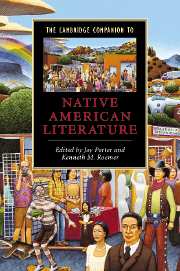Book contents
- Frontmatter
- Introduction
- Timeline
- Part I Historical and cultural contexts
- Part II Genre contexts
- Part III Individual authors
- 10 N. Scott Momaday
- 11 Simon Ortiz
- 12 James Welch
- 13 Leslie Marmon Silko
- 14 Gerald Vizenor
- 15 Louise Erdrich’s storied universe
- 16 Joy Harjo’s poetry
- 17 Sherman Alexie
- Bio-bibliographies
- Further reading
- Index
- Series List
10 - N. Scott Momaday
becoming the bear
from Part III - Individual authors
Published online by Cambridge University Press: 28 May 2006
- Frontmatter
- Introduction
- Timeline
- Part I Historical and cultural contexts
- Part II Genre contexts
- Part III Individual authors
- 10 N. Scott Momaday
- 11 Simon Ortiz
- 12 James Welch
- 13 Leslie Marmon Silko
- 14 Gerald Vizenor
- 15 Louise Erdrich’s storied universe
- 16 Joy Harjo’s poetry
- 17 Sherman Alexie
- Bio-bibliographies
- Further reading
- Index
- Series List
Summary
Beginning in the mid-1960s and throughout the 1970s, a new generation of American Indian writers surprised the mainstream literary establishment by publishing an unprecedented range of innovative poetry, autobiography, fiction, non-fiction, journalism, and mixed-genre works of undeniably high quality. Neither ''American literature'' nor ''American Indian literature'' would ever mean quite what they had in the past, and the assumed distinctions between these categories - written vs. oral or transcribed, sophisticated vs. primitive, familiar vs. exotic - were increasingly questioned by gifted and diverse Indian writers who not only published in all genres but, importantly, began to produce their own body of relevant scholarship. Although many individuals participated in this explosion of Native writing, it is the Kiowa and Cherokee author N. Scott Momaday who is credited with inaugurating this period as the beginning of a contemporary ''renaissance'' for American Indian literature.
Momaday’s reputation was secured in 1969, when his provocative debut novel, House Made of Dawn (1968), won the Pulitzer Prize for fiction and captured the attention of critics. For the first time, the dominant culture in the United States formally acknowledged that twentieth-century American Indians could produce a written literature that was intellectually demanding and “serious.” Early critics noted the novel’s sophisticated techniques of narration and they were intrigued by the novel’s depiction of social alienation in its Indian protagonist and his desperate need to recover a viable identity within his community. These themes resonated with non-Indian audiences of the time, and they could be labeled as “modern” and “universal” rather than exclusively “Indian.” The novel’s striking ambiguities, however, are clearly anchored in its Native contexts, and the difficulty of resolving these ambiguities has insured a steady stream of response by two generations of readers and scholars.
- Type
- Chapter
- Information
- The Cambridge Companion to Native American Literature , pp. 207 - 220Publisher: Cambridge University PressPrint publication year: 2005
- 2
- Cited by

